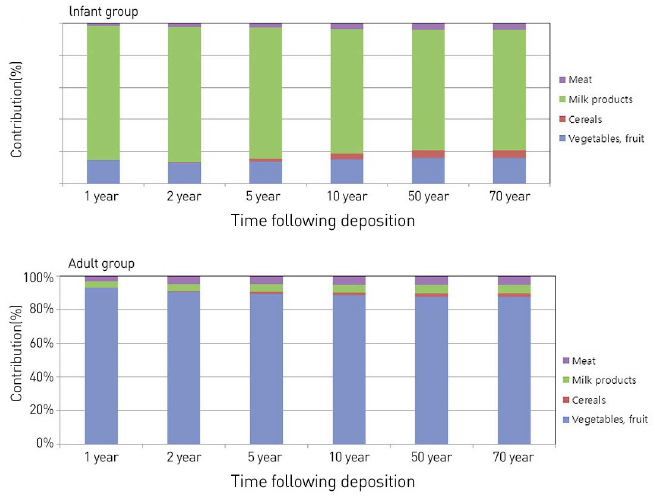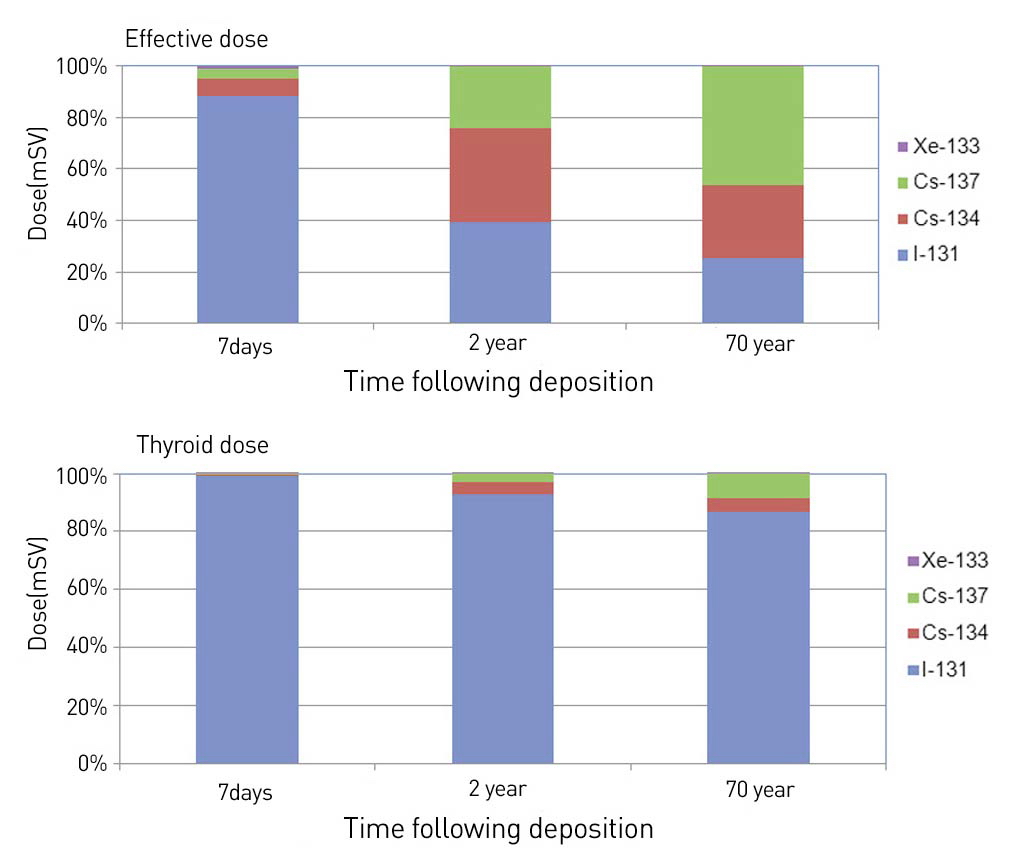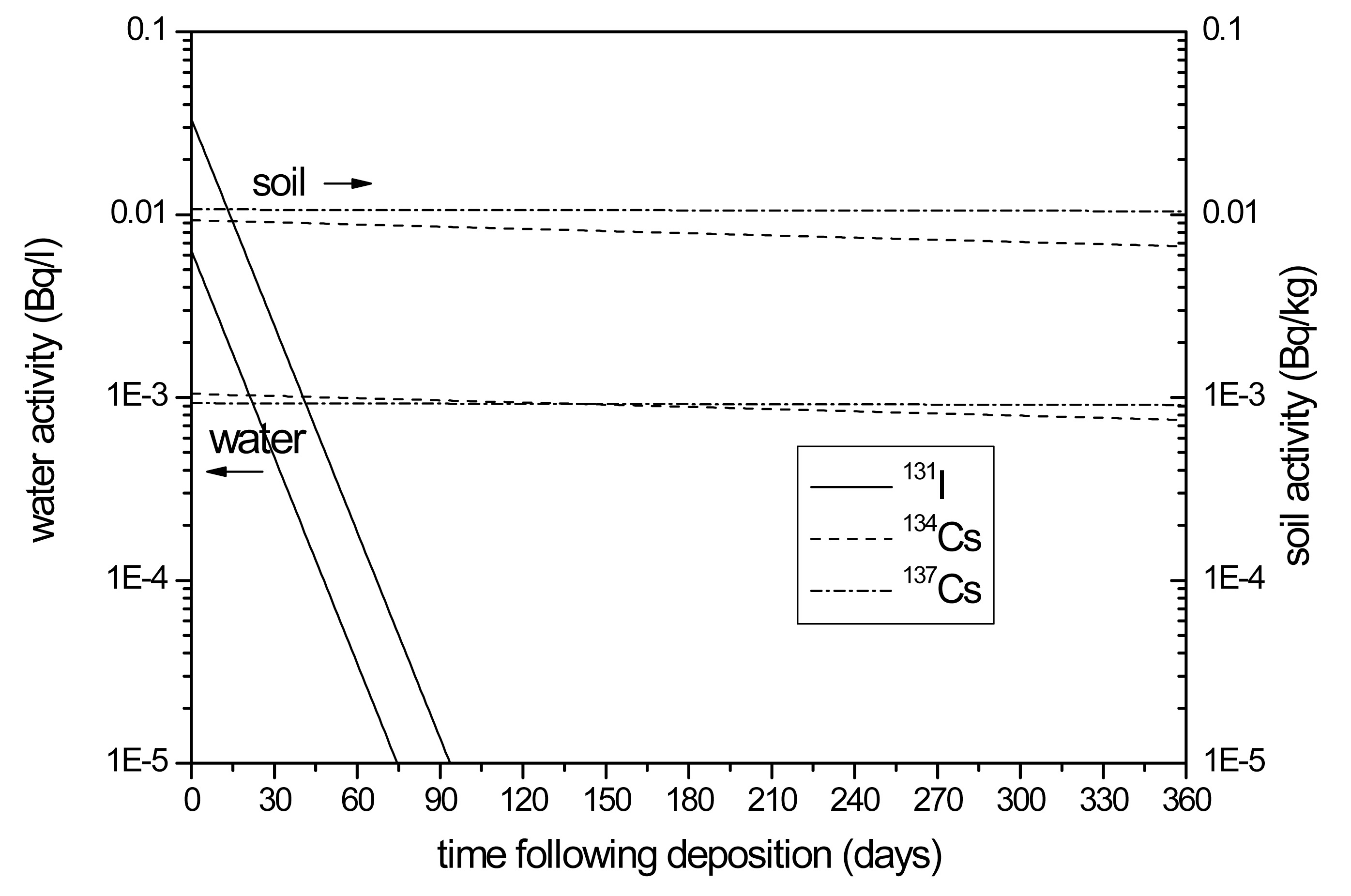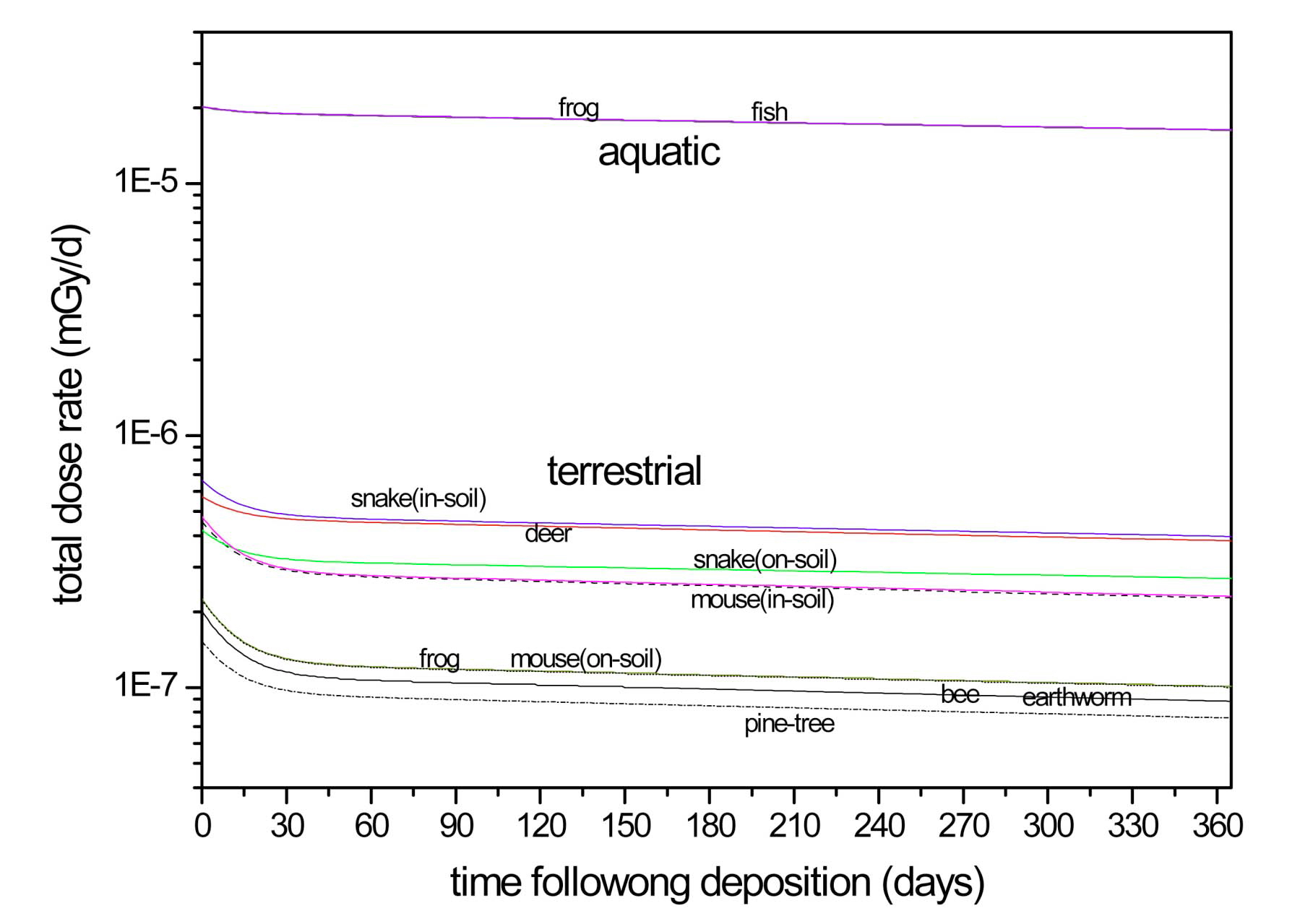



This paper describes the radiation doses to human and non-human biota in the Republic of Korea, as a result of the Fukushima nuclear accident. By using the measured airborne activity and ground deposition, the effective and thyroid doses of five human age groups (infant, 5 years, 10 years, 15 years and adult) were estimated by the ECOSYS code, and the whole body absorbed dose rate of the eight Korean reference animals and plants (RAPs) was estimated by the K-BIOTA (the Korean computer code to assess the risk of radioactivity to wildlife). The first-year effective and thyroid human doses ranged from 5.7E-5 mSv in the infant group to 2.0E-4 mSv in the 5 years group, and from 5.0E-4 mSv in the infant group to 3.4E-3 mSv in the 5 years group, respectively. The life-time (70 years) effective and thyroid human doses ranged from 1.5E-4 mSv in the infant group to 3.0E-4 mSv in the 5 years group, and from 6.0E-4 mSv in the infant group to 3.5E-3 mSv in the 5 years group, respectively. The estimated maximum whole body absorbed dose rate to the Korean RAPs was 6.7E-7 mGy/d for a snake living in soil (terrestrial biota), and 2.0E-5 mGy/d for freshwater fish (aquatic biota), both of which were far less than the generic dose criteria to protect biota from ionizing radiation. Also, the screening level assessment for ERICA’s (Environmental Risks from Ionizing Contaminants: Assessments and management) limiting organisms showed that the risk quotient (RQ) for the estimated maximum soil and water activity was significantly less than unity for both the terrestrial and freshwater organisms. Conclusively, the radiological risk of the radioactivity released into the environment by the Fukushima nuclear accident to the public and the non-human biota in the republic of Korea is considered negligible.
A severe nuclear accident occurred at the Fukushima Daichi nuclear power plants (NPP) in Japan on 11 March, 2011, and a significant amount of gaseous radioactive material was released into the atmosphere and dispersed by wind. The Nuclear and Industrial Safety Agency of Japan (NISA) reported that the amount released into the environment was approximately 10% of the Chernobyl nuclear accident in 1986 [1]. About two weeks after the accident, very low activities of short- and long-lived radionuclides (131I, 134Cs, 137Cs and 133Xe) were observed in air samples collected at local monitoring sites in the Republic of Korea. Figs 1 and 2 show the monitoring sites and the airborne activity of the radionuclides that had been measured by the Korea Institute of Nuclear Safety (KINS), which is responsible for monitoring radioactivity in the Republic of Korea [2]. Airborne 131I activity was first detected at a higher level than the normal on 28 March, 2011, its highest peak was observed over the region on 7 April, 2011, and it declined to the usual background level within about two months of the accident. Once the radionuclides are released to the environment, in principle, they cause risks to human health and the environment, and both humans and biota may be exposed through various pathways. The assessment of the radiation dose to human and non-human biota is essential for the evaluation of impacts to the public and the environment from the effect of ionizing radiation.
After the Fukushima accident, public attention was on the accident, focusing in particular on the monitoring results observed in specific regions of countries [3, 4] or the dispersion of the contaminated cloud [5], while results from the available radiation dose assessments are very limited [6]. Recently, the United Nation’s Scientific Committee on the Effects of Atomic Radiation (UNSCEAR) has launched a project with the objective to develop a scientific report on the levels and effects of radiation exposure due to the Fukushima nuclear accident. The report will address radionuclide releases, dispersion and deposition, and doses and effects for workers, the public and biota in Japan, as well as in countries outside of Japan, as a result of the Fukushima nuclear accident. The purpose of the
present study is to estimate short- and long-term radiological risks to humans and biota in the Republic of Korea, which is a neighbor country of Japan, and to provide input into the world-wide efforts to study the effect of the Fukushima nuclear accident.
For the assessment of doses to humans, the ECOSYS code [7] was used; for biota dose assessment, the K-BIOTA [8,9] was used. All calculations were made based on the airborne activity and ground deposition measured in Korea. The approaches used to assess the radiation dose to human and non-human biota are described in the following.
The ECOSYS code (the Microsoft Excel version) was developed based on the ECOSYS 87 model [10], which is a dynamic model for assessing the radiological consequences of a nuclear accident. The code takes into account five exposure pathways to predict the radiation dose to humans; 1) the internal exposure due to the ingestion of contaminated foodstuffs, 2) internal exposure due to the inhalation of airborne radionuclides, 3) external exposure from the radionuclides in the passing cloud, 4) external exposure from radionuclides deposited on the ground, and 5) external exposure due to radionuclides deposited on skin and cloths. The ingestion pathways include the processes of deposition, interception, translocation, weathering, resuspension, root-uptake, migration in soil, transfer to domestic animals, and the intake activity of animals though contaminated feedstuffs. The model can estimate in particular the contamination of foods and feeds through the uptake of radionuclides directly deposited on the foliage, and through uptake from soil. Details on the modeling of the pathways are well described elsewhere [7, 10]. In the present study, the first four pathways are considered because the contribution of the last exposure pathway to the human dose is usually very low. The considered pathways of radiation exposure to man and biota are shown in Fig 3.
Major input data for the human dose calculation are listed in Table 1. Default input parameter values in ECOSYS
[Table 1.] Major Input Parameters for the Human Dose Calculation
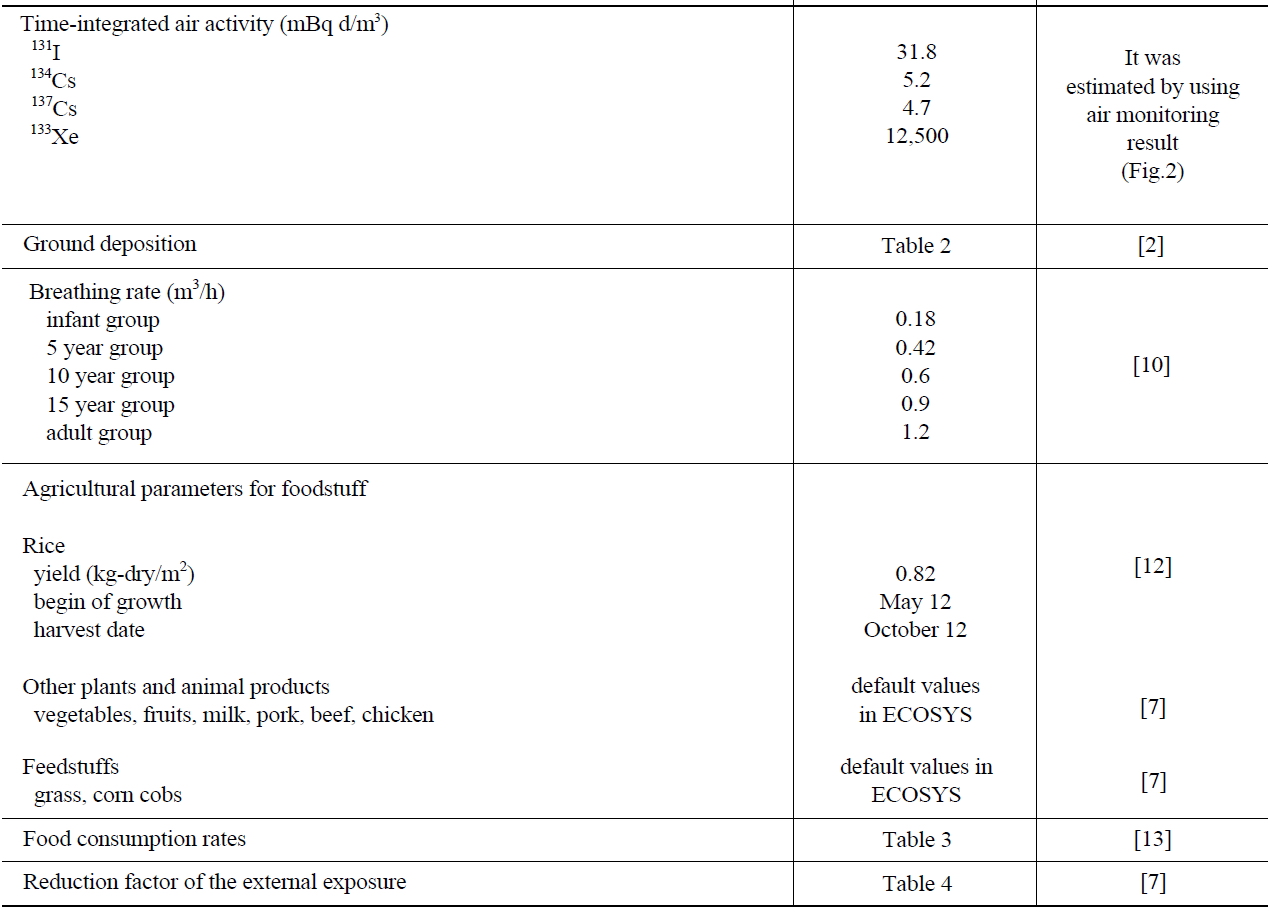
Major Input Parameters for the Human Dose Calculation
were generally used unless described otherwise. Timeintegrated air activity of each site was calculated by integrating the area under the air monitoring peak (Fig.2), and the highest value for each radionuclide was taken as input data for the dose calculation, and is given in Table 1.
After the Fukushima accident, the measured soil activities of 137Cs in Korea were in the normal range (MDA ~ 16Bq/kg), indicating that there was a very little ground deposition. The net amount of ground deposition by the Fukushima accident cannot be exactly determined from the measured soil activities that are comprised of both nuclear weapon and the Fukushima accident fallout. The KINS have measured the dry and wet deposition of radionuclides by using a deposition collector at Daejeon in Korea, since 1998. Table 2 shows the dry and wet deposition that had been measured at Daejeon during March to May 2011 after the Fukushima nuclear accident [2]. The dry deposition of iodine was much lower than the wet deposition, while the amount of dry and wet deposition of cesium is very similar. The low dry deposition of iodine was likely to be ascribed by a little collection of gaseous iodine in the deposition collector, which is made of acrylic plastic. Thus the dry deposition of iodine was estimated by the following equation
Dry deposition (Bq/m2) = [Σ(Fraction of iodine form x Deposition velocity of each iodine form to soil (m/d)] x Time-integrated air activities of iodine (Bq d/m3).
The fractions of iodine form (0.23, 0.27, and 0.5 for aerosol, element, and organic bound iodine, respectively) were taken from measurement results after the Chernobyl accident [11], and the deposition velocities to soil were
[Table 2.] Total Ground Deposition Used in the Calculation [2]

Total Ground Deposition Used in the Calculation [2]
[Table 3.] Korean Age-dependent Annual Food Consumption Rate [13]
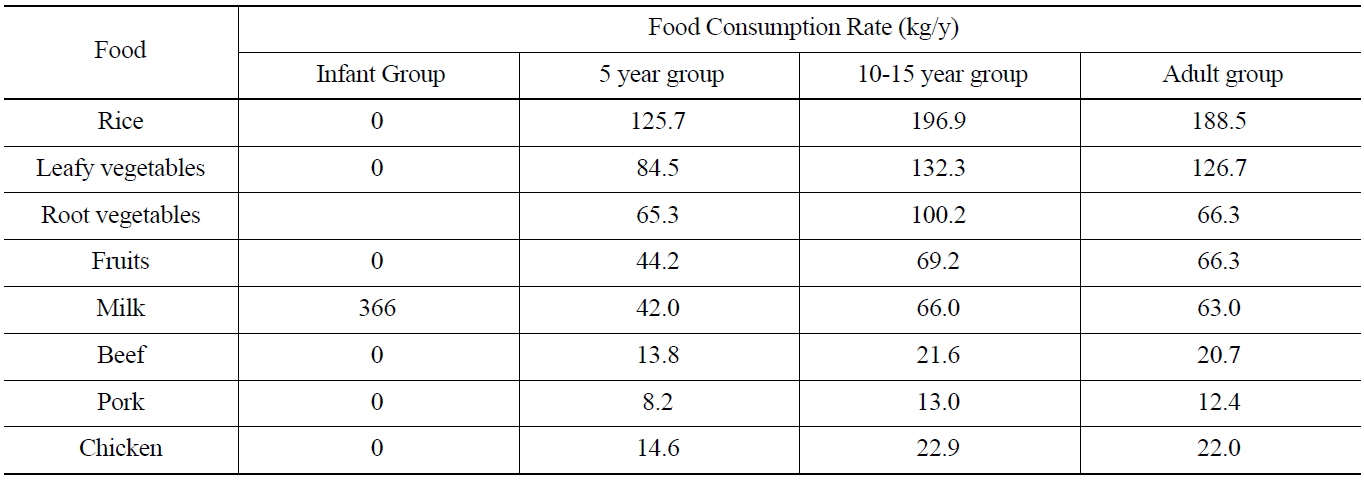
Korean Age-dependent Annual Food Consumption Rate [13]
taken from literature [10]. The total ground deposition of iodine for the human dose assessment was assumed to the sum of the estimated dry deposition with the measured wet deposition.
The breathing rates were 0.18, 0.42, 0.6, 0.9 and 1.2 m3/h for infant, 5 years, 10 years, 15 years, and adult age groups, respectively [10]. Eight foodstuffs of rice, leafy vegetables, root vegetables, fruits, milk, pork, beef and chicken, and three feedstuffs of rice, grass and corn cobs, were considered for the ingestion dose (Fig 3). Among those, the leafy vegetables and grass are likely to be affected by direct deposition of radionuclides on the plants, because they are considered to be harvested throughout the year. There would be no direct deposition on other plants because the accident occurred before planting, and consequently the plants would be mainly contaminated by root uptake. The ECOSYS’s default agricultural parameters for the feedstuffs and foodstuffs, except rice, were applied. Rice, which is a staple crop in Korea, was assumed to be planted on May 21, and harvested with the yield of 0.82 kg-dry/m2 on October 21 [12]. Age-dependent annual food consumption rates were taken from the off-site dose calculation manual [13] and their values are summarized in Table 3. The reduction factor of the external exposure for staying at a different location, which was taken from the ECOSYS code [7], is summarized in Table 4. The reduction factor for the exposure from cloud is very similar to the value (0.36) used for the calculation of the human dose from the Chernobyl accident [11].
2.2 Non-human Biota Dose Assessment
The assessment of exposures for biota is needed to evaluate the radiological impact to communities and populations of wildlife [14]. For planned and existing exposure situations, equilibrium models are often used to assess the radiation dose to biota [15], while for emergency exposure situations, where the activity in biota and environment varies considerably with time, dynamic models are needed. There are a number of dynamic models for the dose assessment of biota, but the kinetic transfer parameters available for the assessment are very limited. Thus, the application of a full dynamic model for biota dose assessment under accidental conditions is not practical at present. Alternatively, a semi-dynamic model can be used to consider the time variation of the environmental medium concentration. In this study, the equilibrium CR model of the K-BIOTA was simply modified to calculate the timedependent whole body absorbed dose rate for a specific organism.
where
[Table 4.] Reduction Factor of the External Exposure [7]

Reduction Factor of the External Exposure [7]
and in sediment, respectively.
Recently, the International Commission on Radiological Protection (ICRP) presented the concept of reference animals and plants (RAPs) [16]. The ICRP reference organism approach uses a few types of organisms that are typical of the major environments, which may serve as a primary point of reference for assessing the radiation dose for non-human biota. The ICRP’s approach is deemed to be the most pragmatic for the non-human biota radiation dose assessment. Based on the ICRP reference organism approach, seven animals and one plant were selected as the reference organisms in the K-BIOTA code [9]. In order to consider the ecological characteristics specific to Korea, the size of the selected organisms was taken from the “Endemic Species of Korea” [17]. The shape of all the organisms was assumed to be ellipsoid (Table 5). In the present study, the Korean reference RAPs were used as target organisms for the radiation dose to non-human biota. Given the geometry of the target organisms and radiation weighting factors (alpha=10, beta=3, and gamma=1), a uniform isotropic model was applied to calculate the internal dose conversion coefficients, and it was also used to calculate the external dose conversion coefficient for aquatic animals [18, 19]. A Monte Carlo simulation was applied to calculate external dose conversion coefficients for terrestrial organisms [20, 21].
[Table 5.] Korean Draft Reference Animals and Plant [9]
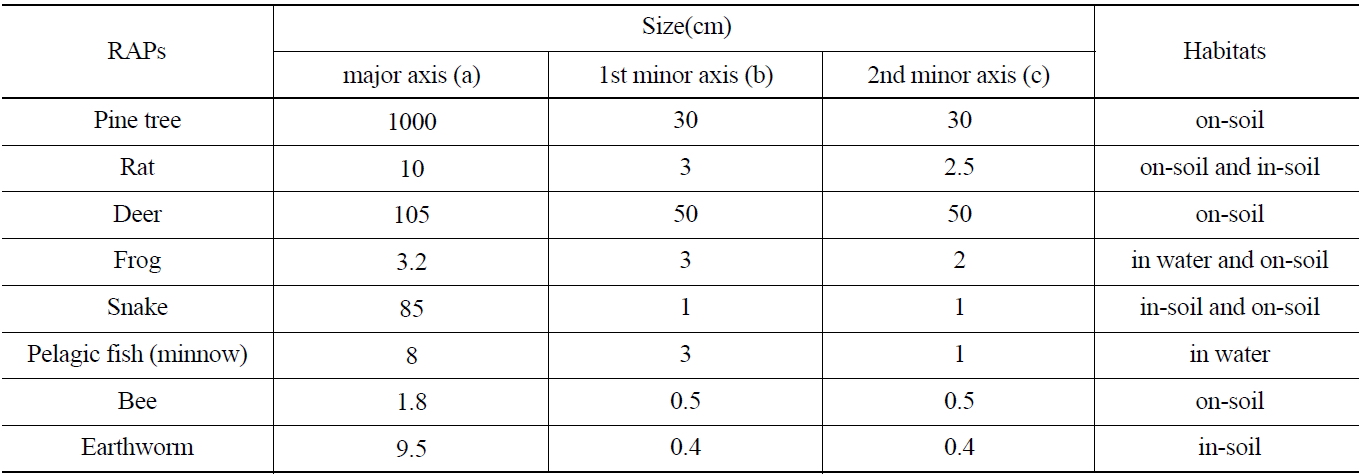
Korean Draft Reference Animals and Plant [9]
The dosimetric model in the K-BIOTA was tested through an extended comparison study on the dose conversion coefficients for some selected organisms in the Biota Working Group (BWG) of the IAEA/EMRAS II project [22]. CR values were taken from the literature [23, 24]. The time-dependent soil (
where
Effective and thyroid doses for the public in the Republic of Korea as a result of the Fukushima nuclear accident are summarized in Tables 6 and 7, respectively. It can be seen that the annual doses decrease with time continuously, after 50 years the annual dose is less than a few percent of the dose in the first year. The first-year includes doses from inhalation and from cloud-shine. From the second year, the differences of doses between age groups are very little. This is due to the fact that the long-lived radionuclides, Cs and 137Cs were the main contributors to the dose, and ground exposure was the dominant pathway in the medium and long term.
The first-year effective dose ranged from 5.7E-5 mSv in the infant group to 2.0E-4 mSv in teenagers. These values are less by orders of magnitude than the annual public exposure to natural radiation (2.4mSv) [25]. It is also lower by a factor of ten than the first-year effective dose (about 7E-3 to 8E-3 mSv) of adults in the East Asia region resulting from the Chernobyl accident [11]. The first-year effective dose of the infant group was about 30 to 40% of the dose of the other age groups. This is due to the low ingestion dose for the infant group. The infant group consumed only milk, and its consumption rate was also less than the total food consumption rates of the other age groups (Table 3). Furthermore, the activity in milk decreased during processing. Other age groups consumed vegetables that were the main contributor of an ingestion dose from the end of deposition. It is interesting that the effective dose from inhalation in the 5 years group was slightly greater than that for the infant groups. This is due to the fact that the breathing rate differs more (a factor of 2.33) between both age groups than the dose conversion factor (a factor of 0.57) of 131I, which was the main contributor to the inhalation dose. The first-year thyroid dose ranged from 5.0E-4 mSv in the infant group to 3.4E-3 mSv in the 5 years group. The effect of inhalation appeared to be higher in the thyroid dose than the effective dose. The inhalation dose contributed 68% (32%) and 24% (10%) to the first-year thyroid dose (effective dose) of infants and adults, respectively.
On the other hand, the annual external cloud dose ranged from 4.8E-7 mSv to 6.9E-7 mSv over all age groups, and turned out to be less than other exposure pathways. The contribution of the external ground exposure to the
[Table 6.] Cumulated and Annual Effective Dose
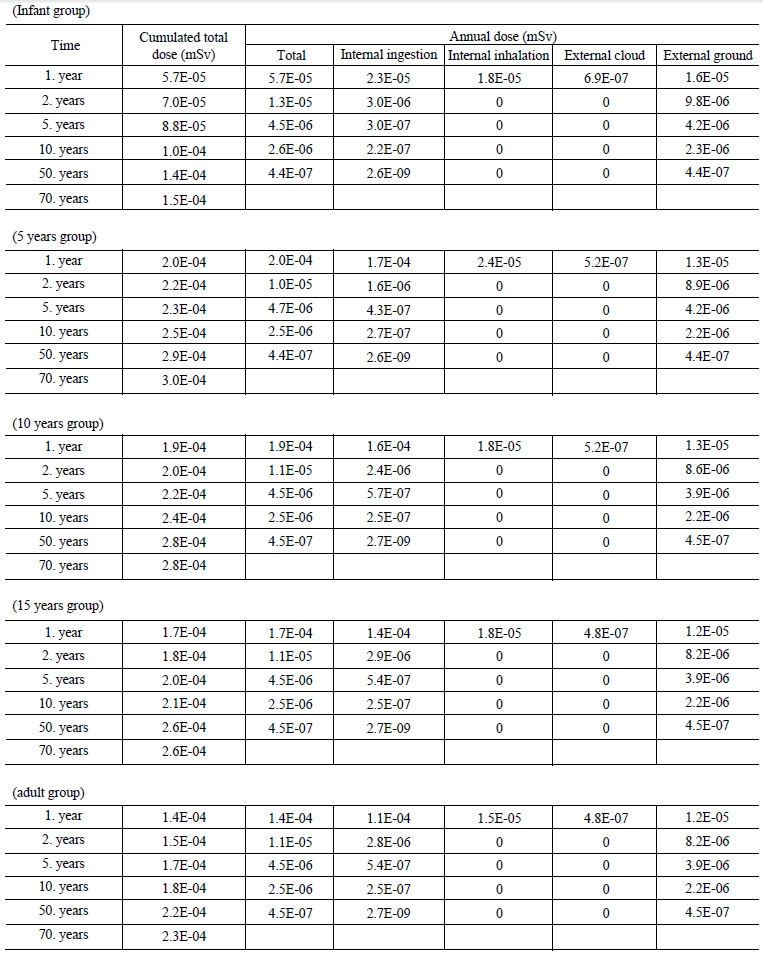
Cumulated and Annual Effective Dose
[Table 7.] Cumulated and Annual Thyroid Dose
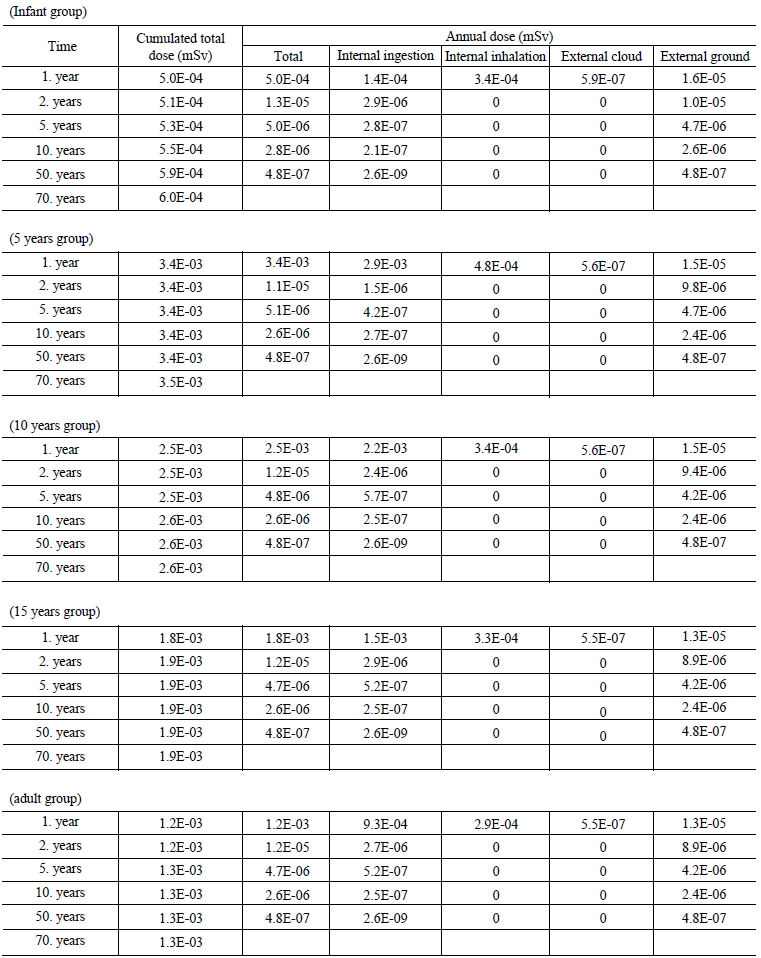
Cumulated and Annual Thyroid Dose
total dose increased with time. For example, the external ground exposure contributed about 8.6% to the total effective dose of the adult group in the first year, while it increased to more than 99.9 % after 50 years.
The cumulated life-time (70 years) effective and thyroid doses ranged from 1.5E-4 to 3.0E-4 mSv, and from 6.0E- 4 to 3.5E-4 mSv, respectively. It means that in the first year after the deposition, the public received 38 to 67% of the life-time effective dose, and 83 to 97% of the life-time thyroid dose, according to age group.
Fig 4 shows the contribution of foodstuffs to the effective ingestion dose of the infant and adult groups. Vegetables were the most predominant contributor to the ingestion dose for the adult group. For the scenario considered, the contribution of vegetables to first-year ingestion dose was 93%, and its contribution to the life-time ingestion dose was 87%. The same trend was observed for all groups above 5 years. All age groups above 5 years were assumed to consume vegetables daily from the end of deposition, since there were no actions to restrict the consumption of domestic vegetables in the Republic of Korea after the Fukushima accident, due to the very low activities in leafy vegetables. Generally, the interception by plant leaves is initially the main contamination pathway of vegetables, and thus the consumption of contaminated vegetables, if relevant, may cause an increase of the ingestion dose. In western countries, where milk products are among the major food stuffs, the grass-cow-milk pathways can also be important pathways with particular importance for the early phase after an accident, since radioiodine ingested by milk cows is rapidly absorbed in the animals, and transferred to milk. In Korea, the consumption of vegetables is much larger than milk, and therefore, vegetables are the highest contributor to the ingestion dose. Other foodstuffs, such as meat and cereal, take time for storage and processing
until eaten, and thus their activity decreases much by the time of consumption. Therefore, the contribution of those foodstuffs to the ingestion dose was not greater than that of vegetables. On the contrary, the ingestion dose for the infant group was greatly attributed to the consumption of milk. The contribution of milk to the first-year ingestion dose for the infant group was estimated at about 83%, and its contribution to life-time ingestion dose was estimated at 75%.
The contributions of radionuclides to the cumulated dose are shown in Fig 5. For the effective dose, 131I was the highest contributor (about 87%) in the first week after the end of deposition, while 134Cs and 137Cs were major contributors in the medium and long term. This is due to the activity of 131I and its short half-life. The dose factor of 131I for thyroid is larger by a factor of hundreds than that of 134Cs and 137Cs. Thus, 131I is the main contributor to the life-time thyroid dose. The radiological impact due to 133Xe was very low, although the airborne activity of the radionuclide was higher by three to four orders of magnitude than those of other radionuclides, and it played the role of dominant contributor to the external cloud dose. This result was consistent with the very low contribution of the external cloud exposure to the total dose.
Soil and water activities were calculated from eqs (3) and (4) by using the time-integrated air activity and fallout deposition. In the calculation, the same time-integrated air activities and soil deposition as those used for the human dose assessment were used for consistency (Table1 and 2). The model parameter values used were a soil density of 1500 kg/m3, soil depth of 10cm, and water body depth of 5m. The deposition velocity to water surface (
Fig 6 shows the calculated time-dependent soil and water activities (left: water activity, right: soil activity). The estimated maximum soil activities were 3.3E-2 Bq/kg for 131I, 9.3E-3 Bq/kg for 134Cs, and 1.1E-2 Bq/kg for 137Cs. The estimated maximum water activities were 6.4E-3 Bq/l for 131I, 1.1E-3 Bq/l for 134Cs, and 9.3E-4 Bq/l for 137Cs. For all radionuclides considered, the maximum values were obtained at the end of deposition, due to the least reduction in the radioactivity by radiological decay. It is a natural result that because of the short half-life (8 days) of 131I, the activity decreased to a negligible level a few months after the deposition, while the activity of the long-lived Csisotopes (134Cs=2.06 years, 137Cs=30years) decreased slowly.
Fig 7 shows the time-dependent whole body absorbed dose rates of the Korean reference animals and plants. For all organisms considered, the maximum dose rate was obtained at the end of deposition because the soil and water activities were at the maximum at the time. If the trophic chain between biota is considered, the delayed maximum dose rates may be obtained for a predatory organism, owing to the time required for the transport of radionuclide through the food web [27]. The dose rates to the terrestrial organisms increased in the order of snake (in-soil) > deer > snake (on-soil) > mouse (in-soil) > frog > mouse (on-soil) > earthworm > bee > pine tree. The different whole body absorbed dose rates between organisms were caused by the difference in size, habitat, and CR value of the organisms. The value of the highest dose rate for terrestrial organisms was 6.7E-7 mGy/d for the snake (insoil), and the value of the lowest dose rate for terrestrial organisms was 1.5E-7 mGy/d for the pine tree. The maximum whole body dose rate to aquatic frogs and fish (Chinese minnow) was about 2.0E-5 mGy/d. For the aquatic animals considered, the occupancy factors were assumed
to be
In addition to the Korean reference animals and plants, the default reference organisms of the ERICA (Environmental Risks from Ionizing Contaminants: Assessments and management) assessment tool [29] were also studied. Of the default ERICA reference organisms, the organisms that receive the highest dose from a specific radionuclide in an ecosystem were selected for the target biota. The ERICA limiting terrestrial organism is reported to be bird egg for 131I, and mammal (deer) for 134Cs and 137Cs; the limiting freshwater organism is phytoplankton for 131I, and insect larvae for 134Cs and 137Cs. For the screening level assessment, the
where
limiting organism are 2.1E1 Bq/l for 131I (phytoplankton), and 2.1E-2 Bq/l for 134Cs (insect larvae), and 5.1E-2 Bq/l for 137Cs (insect larvae). For the estimated maximum soil and water activities (Fig 6), the calculated RQ value by Eq(5) was 1.9E-4 for the terrestrial ecosystem and 9E-2 for the freshwater ecosystem. Both values are well under the unity, and this result supported that the radiological risks to non-human biota as a result of the Fukushima nuclear accident is considered negligible. The DMCL for the screening level assessment was derived with the assumption of the constant medium activity concentration, based on the equilibrium model, and thus the approach may be invalid when there is pronounced time-dependence of exposure in the early phase after an accident. However, the equilibrium model is a basically conservative approach since the biota activity for the initial phase must be less than its activity at equilibrium. Therefore, if the RQ value based on the equilibrium model is less than unity, even for the maximum environment activity concentration that are observed at the initial period after an accident, it can be assured that the radiological risks to non-human biota can be negligible over all periods.
The radiation doses to human and non-human biota in the Republic of Korea as a result of the Fukushima nuclear accident were estimated. The first-year effective and thyroid human doses ranged from 5.7E-5 mSv in the infant group to 2.0E-4 mSv in the 5 years group, and from 5.0E-4 mSv in the infant group to 3.4E-3 mSv in the 5 years group, respectively. The life-time effective and thyroid human doses ranged from 1.5E-4 mSv in the infant group to 3.0E-4 mSv in the 5 years group, and from 6.0E-4 mSv in the infant group to 3.5E-3 mSv in the 5 years group, respectively. Among the terrestrial organisms considered, a snake living in soil received the maximum whole body absorbed dose of 5.7E-7 mGy/d, and the freshwater fish of aquatic organisms received the maximum whole body absorbed dose rate of 2.0E-5 mGy/d. Both values for the maximum whole body absorbed dose rates are several orders of magnitude lower than the generic dose criteria to protect biota from ionizing radiation. Furthermore, the screening level assessment for ERICA’s limiting organisms showed that the risk quotient (RQ) for the maximum soil and water activities was significantly less than unity for both the terrestrial and freshwater organisms. Thus, it can be concluded that the risk to the public and biota in the republic of Korea, from the radioactivity released due to the Fukushima nuclear accident is considered negligible. In fact, this is a natural result, considering that the activities deposited on the ground are very low compared to weapons fallout.
In the present study, a simple semi-equilibrium model, as an alternative to the full dynamic radioecological model, was applied to assess the dose rate to non-human biota. It should be noted that the model can lead to an excessively overestimated result, and may be not valid for the early phase after an accident where there is strong time- variation of radioactivity in environmental components. To analyze the accident situations more realistically, future studies are needed to address the development of the full dynamic radioecological model, in which the radionuclide transfer between the constituent components are linked each other, along with a measurement of the related kinetic parameters, particularly for terrestrial organisms.


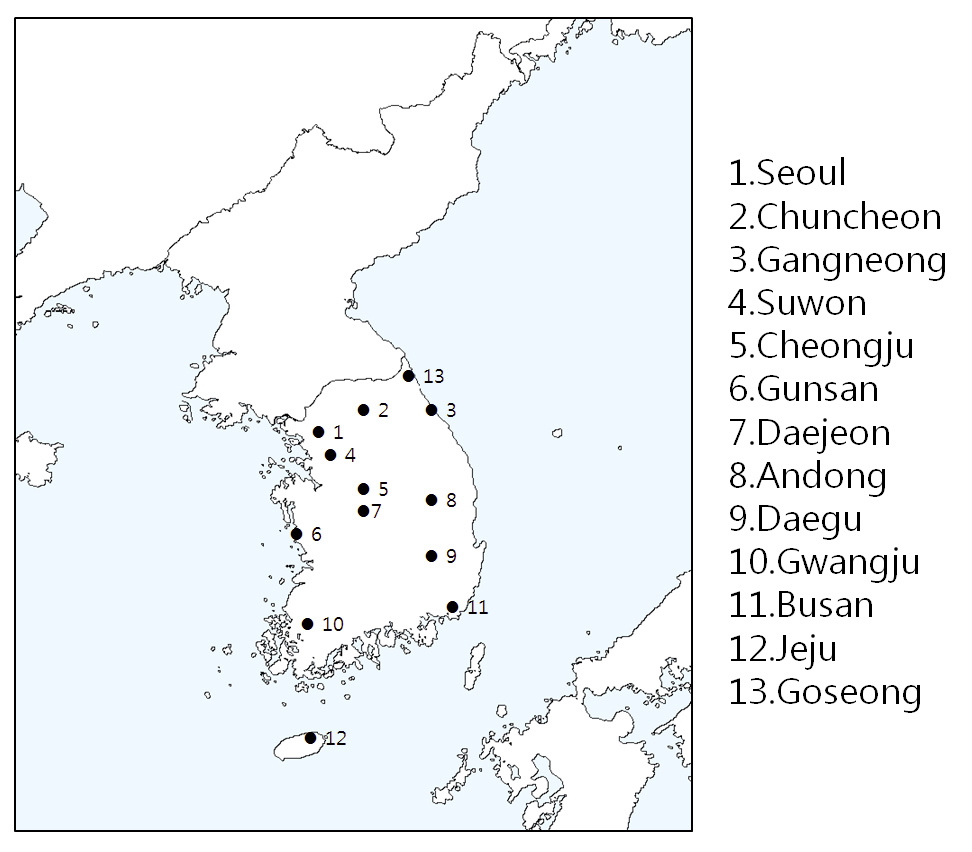
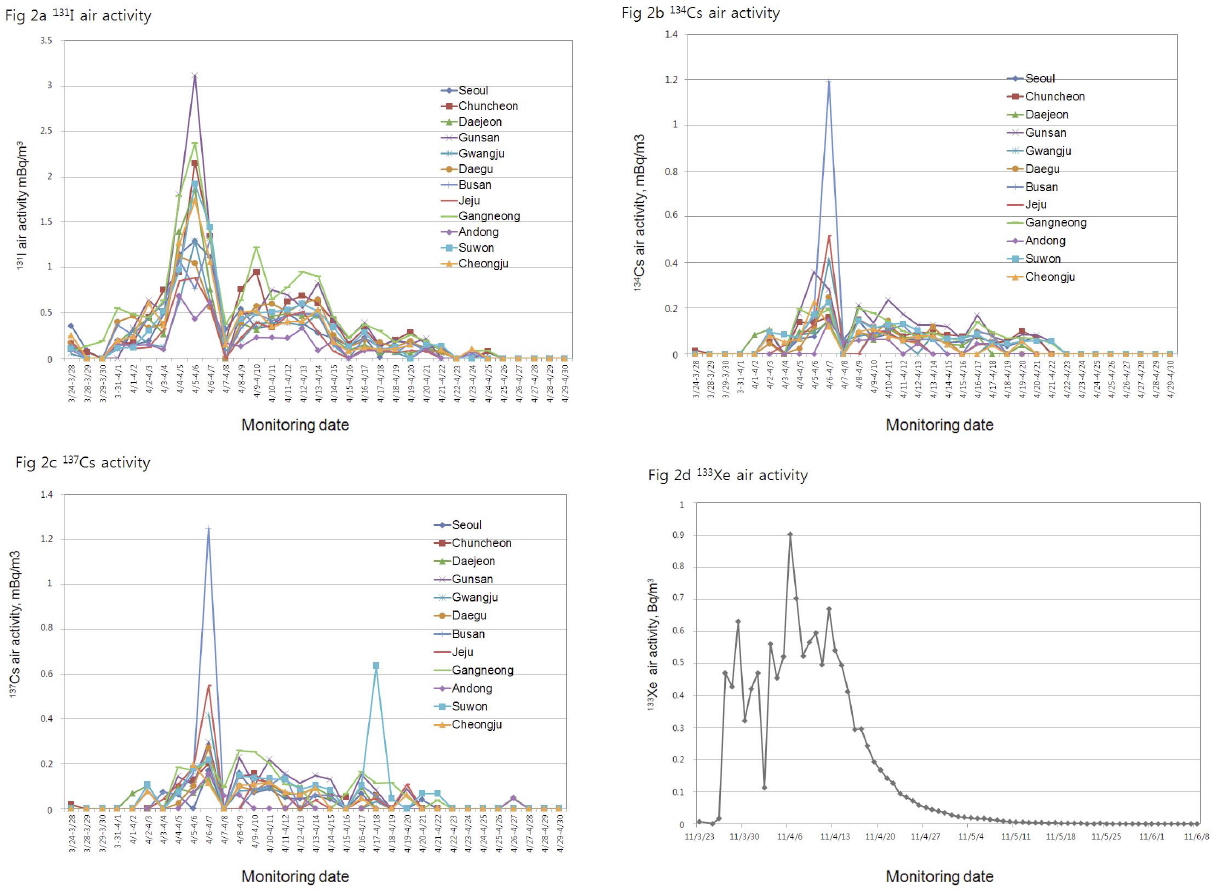

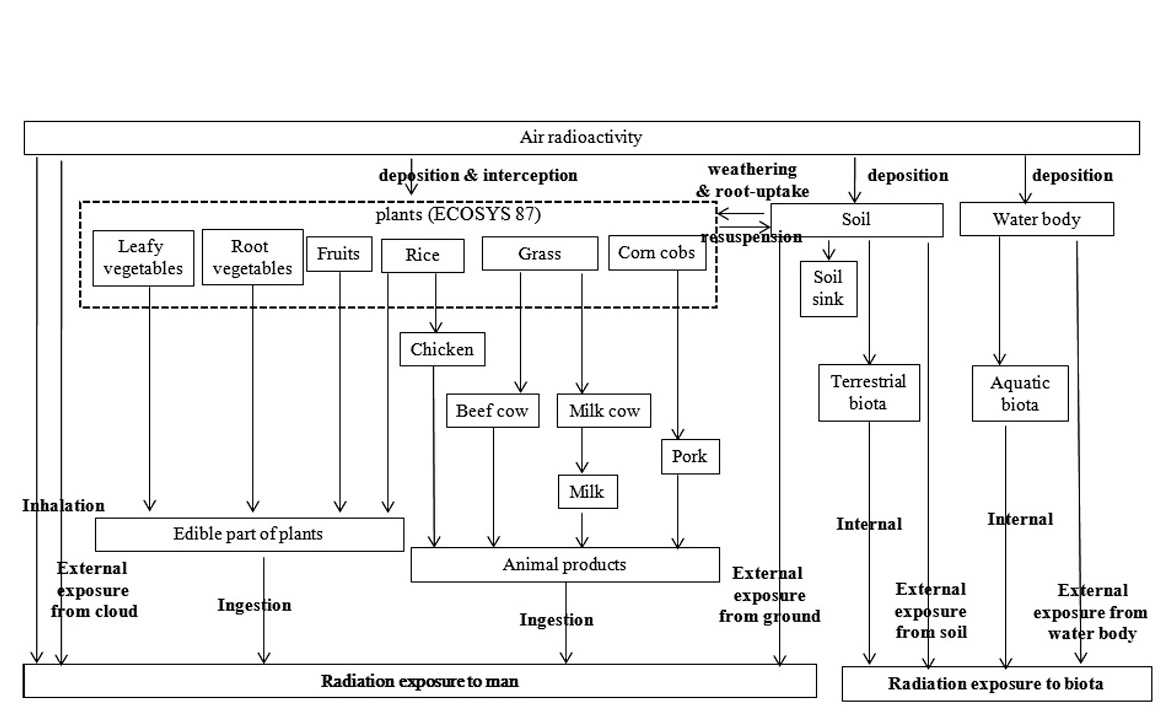
![Total Ground Deposition Used in the Calculation [2]](http://oak.go.kr/repository/journal/12571/OJRHBJ_2013_v45n1_1_t002.jpg)
![Korean Age-dependent Annual Food Consumption Rate [13]](http://oak.go.kr/repository/journal/12571/OJRHBJ_2013_v45n1_1_t003.jpg)
![Reduction Factor of the External Exposure [7]](http://oak.go.kr/repository/journal/12571/OJRHBJ_2013_v45n1_1_t004.jpg)
![Korean Draft Reference Animals and Plant [9]](http://oak.go.kr/repository/journal/12571/OJRHBJ_2013_v45n1_1_t005.jpg)


